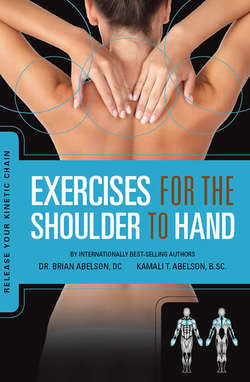Читать книгу Exercises for the Shoulder to Hand - Release Your Kinetic Chain - Dr. Brian James Abelson DC. - Страница 12
На сайте Литреса книга снята с продажи.
ОглавлениеAthletic or Performance Care Routines
The major focus of the Release Your Kinetic Chain series of books is to help you resolve your injuries and to prepare your body for possible performance-level training.
• If your primary objective is to resolve an injury and you have no interest in athletic or performance care, then you can move directly to the next chapter.
• For the rest of you, there are several factors you should consider once you have attained a level of fitness where your body is ready to begin performance training.
Athletic performance training is all about speed, power, and strength, which in turn are based on the development of superb neuromuscular control. Great neuromuscular control (the training of your nervous system to perform a task) is what defines the world’s best athletes – not strength or muscle size. There are some similarities (as well as some huge differences) in the objectives of rehabilitative exercise and athletic or performance training. In both, the development of neuromuscular control remains critical.
Athletic or Performance training has greater risks than rehabilitation training. Athletic training often involves riding the fence between overloading the body (to increase strength and power) and reaching the point of tissue failure (injury). In Performance training there is always a greater chance of injury. Athletic or performance training differs from rehabilitative training in its:
Increased risk of injury.
Need to work through muscle pain.
Need to increase resistance to the point of overloading the muscles.
Requiring speed training.
Development of the anaerobic system.
The following are a few fundamental principles that you should keep in mind as you progress into Athletic training routines:
Principle 1: Athletic Development is Not the Same as Body-Building! - page 11
Principle 2: Good Tissue Quality = Good Performance - page 12
Principle 3: Some Muscle Pain is Okay - page 13
Principle 4: Develop Your Aerobic Zone Before Working on Your Anaerobic Zone - page 14
Principle 1: Athletic Development is Not the Same as Body-Building!
Exercise programs that focus only on increasing muscle size serve to meet body-building objectives of increasing size and definition and have very little to do with improved athletic performance or improved body function.
Athletic Performance training typically focuses upon developing your speed, power, and strength. To achieve this goal, you must establish good muscle endurance, good motor control, and superb neuromuscular responses. This is very different from body-building which focuses primarily on increasing the size and bulk of your muscles.
Exercise programs that focus only on increasing muscle size by isolating specific muscles (weight training with machines) often result in muscular imbalances, soft tissue injuries, and an overall decrease in performance. This is one of the reasons we do not recommend the use of exercise machines (other than cable machines) in any of our routines.
Look for athletic training programs that integrate elements of strength, endurance, speed, and power. These are the ones that will be most helpful in increasing your performance.
